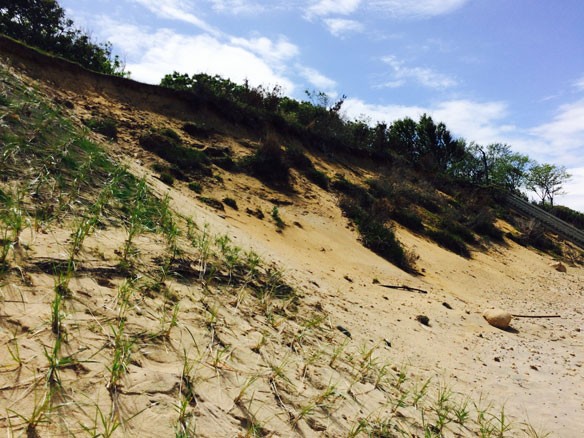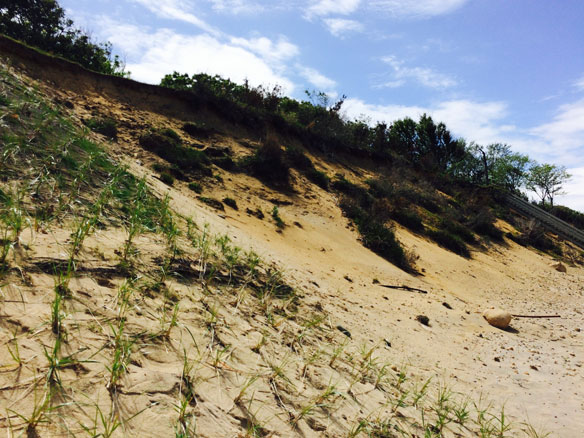
Coastal restoration. Photograph: © SAF — Coastal Care
“In response to the detrimental environmental impacts caused by traditional erosion control structures, environmental groups, state and federal resource management agencies, now advocate an approach known as “Living Shorelines”that embraces the use of natural habitat elements such as indigenous vegetation, to stabilize and protect eroding shorelines.” —Orrin H. Pilkey, Rob Young, Norma Longo & Andy Coburn
Excerpts;
Tropical Storm Hermine may be long gone, but some Shore towns in New Jersey are still feeling the effects and planning for future storms…
In Brick, Mayor John Ducey said he’s not calling for sand to be trucked in because future storms would wash it out to sea. Instead, township crews are pushing up sand onto shore at low tide to build up the beach and cover the wall…
Read Full Article, NJ News (09-10-2016)
The Jersey Shore’s Unquenchable Thirst for Sand; Philly (03-09-2015)
New Jersey, with its 127-mile coastline, has spent about $800 million on beach replenishment over the last 30 years – more than any other state, including Florida, which has an 1,800-mile coastline. That is equivalent to 80 million cubic yards of sand – or about a dump truck load for every foot of beach…
Beach replenishment may have far reaching impacts on ecosystems;” Phys.Org (03-29-2016)
UC San Diego biologists who examined the biological impact of replenishing eroded beaches with offshore sand found that such beach replenishment efforts could have long-term negative impacts on coastal ecosystems…
Is Beach Renourishment Worth The Money? WWAY News (02-16-2015)
Economy Winner, Environment Loser in Renourishment; Pensacola News Journal (12-02-2015)
Palm Beach Mid-Town Dredge Project, A Youtube Video (02-04-2015)
“Beach nourishment projects like this have become commonplace along the US East and Gulf Coasts. These projects have immediate environmental impacts through burial of nearshore habitat and increased turbidity during project placement.The cumulative environmental impacts of doing this repeatedly on the same beach while conducting projects from Maine to Texas is unknown. But, we should be concerned. ” —Robert S. Young, PhD, Director, Program for the Study of Developed Shorelines, Professor, Coastal Geology, Western Carolina University
Marine life dwindles after beach renourishment at Folly Beach, SC, The State (08-20-2016)
Coastal geologist criticizes beach renourishment efforts; The State (08-16-2016)
Piling sand to stop erosion ultimately made the land sink, study says, NOLA (12-26-2015)
Editorial: Beach Replenishment is No Cure-All, Asburry Park Press (05-14-2015)
“Seawalls Kill Beaches,” Open Letters by Warner Chabot And Rob Young; (10-03-2014)
A report and open letter from coastal geologists Warner Chabot and Rob Young, presented to the Ocean Protection Council (OPC) meeting in Sacramento, held on August 26th, 2014…
“Engineering away our natural defenses: An analysis of shoreline hardening in the US,” A Study by By Rachel K. Pittman, ResearchGate (08-08-2015)
Rapid coastal population growth and development are primary drivers of marine habitat degradation. Although shoreline hardening, a byproduct of development, can accelerate erosion and loss of beaches and tidal wetlands, it is a common practice globally. 22,842 km of continental U.S. shoreline, 14% of the total, has been hardened…
Coastal erosion needs our attention, South Coast Today (01-04-2016)
Living shorelines a more natural approach to preventing coastal erosion; (05-18-2016)
For centuries, large bulkheads have been used to help control erosion along coastlines. More recent research suggests that a natural approach may be a better alternative. Having nature on your side, especially during a storm or hurricane, is proven to provide better protection from coastal erosion…
Rethinking Living Shorelines, By Orrin H. Pilkey, Rob Young, Norma Longo, and Andy Coburn;Program for the Study of Developed Shorelines / Western Carolina University, March 1, 2012, Nicholas School of the Environment, Duke University
In response to the detrimental environmental impacts caused by traditional erosion control structures, environmental groups, state and federal resource management agencies, now advocate an approach known as “Living Shorelines”that embraces the use of natural habitat elements such as indigenous vegetation, to stabilize and protect eroding shorelines.









